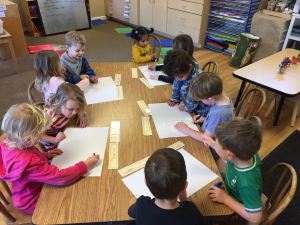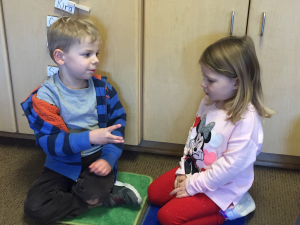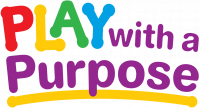When people do art, they have their own ideas and ambitions as to what they are going to create. I may use a special vacation photo and recreate it into a large watercolor, whereas a three-year-old may want to move their arm all around and watch the color from a crayon mark the paper. Each experience is enjoyed, meaningful, and personal. But what happens when we are told we must create collaborative art with someone else or a group? If any of you watch Project Runway on TV, you know that every time the clothing designers are told their next challenge involves working with a group, they all groan and say they hate working with others. Compromising creative ideas is a big challenge for most people, no matter how old they are.

Why do collaborative art?
Collaborative art is a great teambuilding exercise for groups of all ages. However, with my three- and four-year-olds, the focus is not on the artistic product (as with all the art we do at school), but instead, I lead this exercise to help support:
- Following instructions
- Two-way communication
- Flexible thinking
- Compromise
- Sharing
- Planning
- Problem solving
Although I have not done this yet, I think this would be a great exercise to repeat several times during the school year as social-emotional skills grow, and children become familiar with the exercise’s expectations.
How we do it

During circle time, I explain the entire project to the children. They decide together on a drawing, one crayon color, and who will start the drawing. I divide children into groups of two and ask them to discuss with each other something they would like to draw together. I listen carefully to their conversations and help guide their thoughts in a collaborative direction.
“This is a we project, not an I project.”
“So, Lauren, you say that you will be drawing a horse. Erik, did you agree to draw a horse with Lauren?”
After they all mutually decide and announce to the rest of the class what they are drawing together, then they mutually decide what color crayon to use. After that, they decide who will start the drawing with their one shared crayon. When I go around and ask them who is going to draw first, I will sometimes hear two “me” in unison! This is a great opportunity to talk to the group about compromise. It’s also heartwarming to have a child easily give up the start position and tell his/her classmate, “You can go first.”

Partners making decisions about what to draw, crayon color, and who will draw first.
Time to draw
Each pair sits in front of a piece of paper with its crayon on the table. When I say “go,” one child in each pair begins the picture while his/her partner watches. I have a minute timer on, and when the alarm goes off, I say “switch” and the child hands the crayon to his/her partner. Some children continue to talk and coach each other through the drawing. But, I’ve had a couple that have gone off on their own individual tangents and create two separate pictures. Continue having the children switch every minute, giving them equal time to work on the picture. You can regulate the number of switches based on the children’s interest level.

Give it a try – with anyone or any group
The great thing about this collaborative exercise is that any group of any age can do it. It can be a lot of fun to do with your family! Or a fantastic teambuilding exercise in the workplace. It can be done with high schoolers, as well as young children on the cusp of playing in the cooperative play stage. Listening to participants’ communication with each other tells a lot about developmental stages in young children, and personality traits in older children and adults. Sharing art shakes up the me-centric aspect of art and provides a great opportunity to socially and emotionally challenge children. Give it a try and share your classes creations!






Leave A Comment